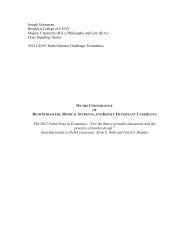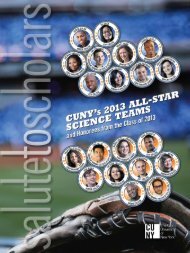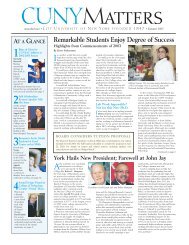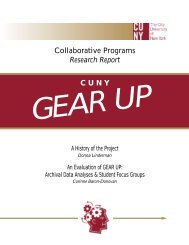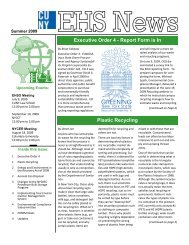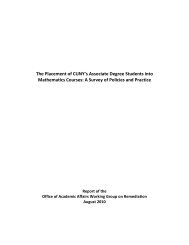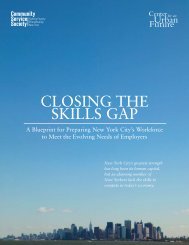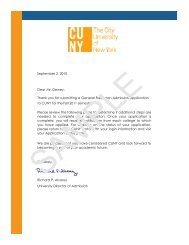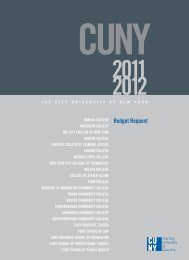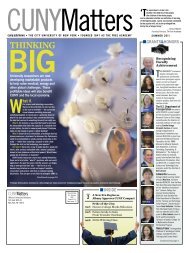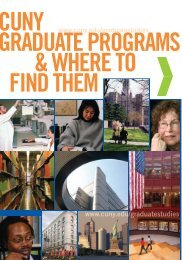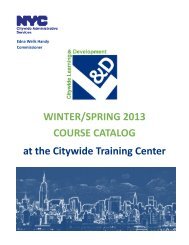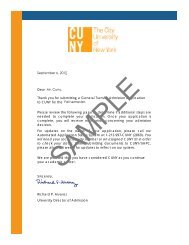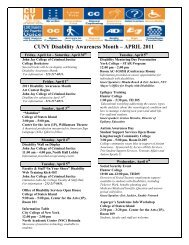CUNY Master Plan 2012-2016
CUNY Master Plan 2012-2016
CUNY Master Plan 2012-2016
Create successful ePaper yourself
Turn your PDF publications into a flip-book with our unique Google optimized e-Paper software.
THE <strong>CUNY</strong> MASTER PLAN <strong>2012</strong>-<strong>2016</strong><br />
<strong>CUNY</strong> SustainableWorks<br />
Having successfully developed a collaborative process that enables the solar market, <strong>CUNY</strong> SustainableWorks<br />
is continuously working to leverage that platform to enable the market for other cleantech<br />
innovations and processes through the following:<br />
• Sustainable Business Leaders Advisory Board: Established in 2010, over thirty city agencies, workforce<br />
development entities, academia and businesses leaders work across the continuum to grow the<br />
green economy.<br />
• NYCleantech Collaborative (NYCC): Initiated in January <strong>2012</strong>, this membership organization of<br />
leading industries identifies key flagship cleantech projects that can make a substantial difference to<br />
the city’s sustainable future and collaborates on streamlining entry to the marketplace. NYCC also<br />
works with the Con Edison Scholar Programs that provides hands-on cleantech project management<br />
experience for <strong>CUNY</strong> graduate students.<br />
• <strong>CUNY</strong> SustainableWorks Commercialization Program: Through a million dollar investment fund, this<br />
program supports emerging cleantech, and works with NYCC to provide a pathway into the marketplace.<br />
The program operates out of the Collaboration Center located at the Borough of Manhattan Community<br />
College.<br />
• <strong>CUNY</strong> Ventures: In an effort to enable the market for cleantech and generate new revenue streams,<br />
<strong>CUNY</strong> Ventures was established as a for-profit initiative. One initial project, through SunShot NY,<br />
will use IBM’s Intelligent Operations Center (IOC) technology solutions to track data from various<br />
sources and provide analytics on PV performance data and local grid impacts. Future plans include<br />
furthering the partnership with IBM to expand the IOC to be a smarter tool for use in any city, with<br />
services bringing in funds to <strong>CUNY</strong> while engaging faculty and students on cutting-edge solutions to<br />
21st-century challenges.<br />
Administrative Technology<br />
The relatively close proximity of the <strong>CUNY</strong> campuses facilitates, and necessitates, the sharing of<br />
resources and services that would be much more difficult—and less needed—were the campuses more<br />
physically dispersed. As noted previously, students transfer frequently among the campuses. Employees<br />
also frequently change their home-base campus, and both students and employees may spend a day, a<br />
month, or a term on another campus. Such frequent human interchange, in order that it be productive,<br />
requires that the administrative systems across the system communicate with each other and facilitate<br />
the work of all students and employees, not just those on a particular campus. These shared administrative<br />
services, including services involving administrative technology, also provide economies of scale and<br />
result in better service to students and faculty while reducing costs to the University. Such services both<br />
promote and are the product of the integrated University.<br />
A prime example of such shared resources is <strong>CUNY</strong>first, a University-wide initiative to upgrade and<br />
integrate database systems that manage student administrative, human resources, and finance business<br />
processes. <strong>CUNY</strong>first will replace dozens of aging software systems that do not interact with a single<br />
88



